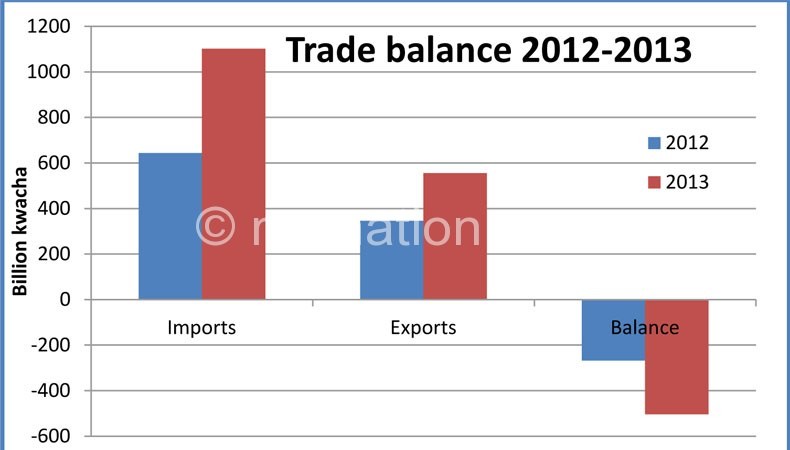Malawi trade balance worsens, hits K503.9bn

Malawi’s trade balance—the difference between imports and exports—worsened to K503.9 billion in 2013, an indication of the country’s insatiable appetite for foreign goods and services.
Reserve Bank of Malawi (RBM) 2013 report and accounts released last week indicate that the increasing trade balance worsened by about 88 percent from K268.5 billion in 2012.
According to the central bank’s annual review, the value of exports increased marginally to K554.8 billion from K345.6 billion in the preceding year while imports valued at K1.1 trillion in 2013 rose from K643.9 billion recorded in the previous year.
As a result of the worsening trade balance, the current account balance—trade balance and net financial transfers, and investments—registered an estimated deficit of K447.3 billion in 2013 compared to a deficit of K208.9 in 2012—a sign that Malawians are spending are spending a lot more abroad than they are taking in thereby threatening Malawi’s net foreign assets.
Against the background of ballooning imports relative to exports, in 2012 the government launched the National Export Strategy (NES) which focuses on three export-oriented clusters for diversification: oilseeds products, sugar cane and manufactures.
The NES provides a road map for developing Malawi’s productive base to allow for both export competitiveness and economic empowerment.
This year, during the State of Nation Address, President Peter Mutharika said that the new government will continue implementing the NES which runs up to 2018.
In addition, to the implementation of the NES, the government will facilitate the promotion of quality in local products and promote the Best-Buy-Malawian campaign, empower Malawians to venture into tangible businesses through deliberate economic empowerment strategies, and support Malawians to enter into joint ventures with foreign investors.
Regardless of worsening trade balance, the RBM in the 2013 annual review has said that revised national accounts estimates portray that Malawi’s GDP grew by 6.1 percent in 2013, compared to a growth of 2.1 percent in 2012.
The central bank has said that the turnaround in economic performance last year is attributable to a marked improvement in fuel availability and increased access to foreign exchange for industries requiring imported raw materials and intermediate goods.
Malawi’s GDP growth was also underpinned by improvement agriculture output, particularly tobacco production which grew by over 100 percent and led to higher disposable incomes and improved domestic demand compared to 2012, according to the RBM.
As a result, the central bank has indicated, wholesale and retail activity, information and communication services, transport, and storage services, manufacturing and construction industries experienced solid growth rates in 2013.





